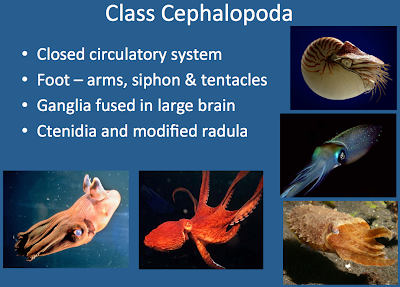 |
| Mollusca: Scaphopoda and Aplacophora Top: Scaphopodan shell and foot Bottom: Chaetodermomorph (photo) and neomeniomorph (photo) aplacophorans |
Today we briefly covered the lesser known molluscan groups Scaphopoda ("boat-like foot" molluscs) and Aplacophora (molluscs "without a shell"). We discussed their bauplan and some of their most important aspects of their ecology.
 |
| Annelida Left column: An errant and a sedentary polychaetes Right column: Clitellates - Oligochaeta (photo) and Hirudinea (photo) |
Then we began discussing the phylum Annelida, the segmented worms. We began with their bauplan, and then started with one of the groups: Polychaeta, the most diverse of the annelids. We covered their general characteristics and focused on the errant polychaetes. Next week, the sedentary polychaetes, and the clitellates.
-----------------------










